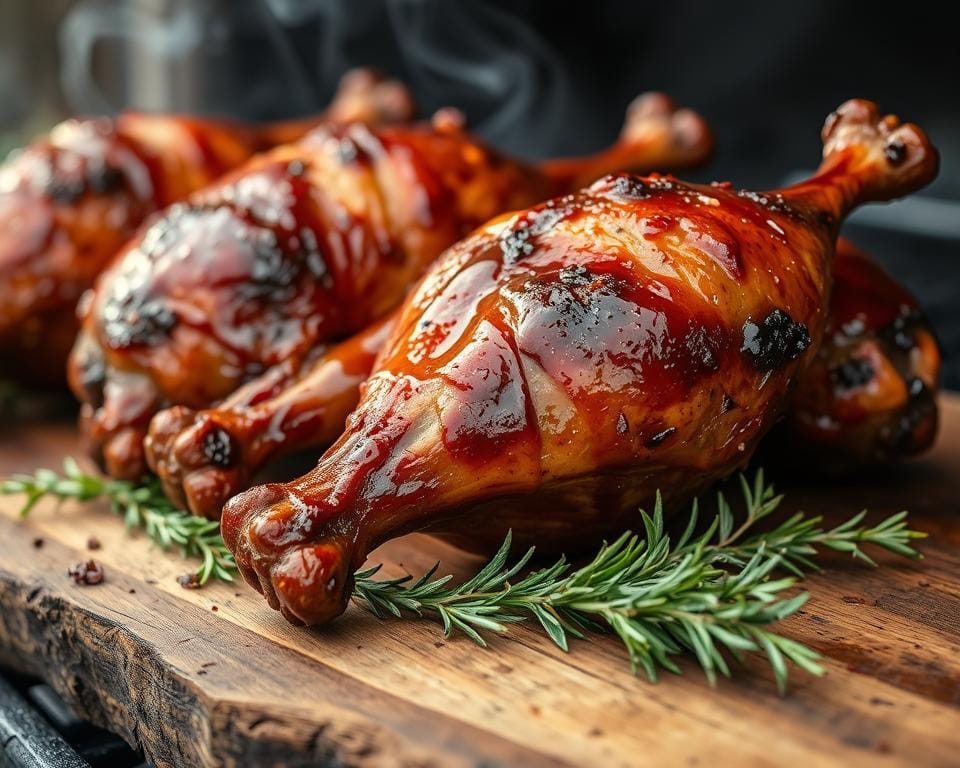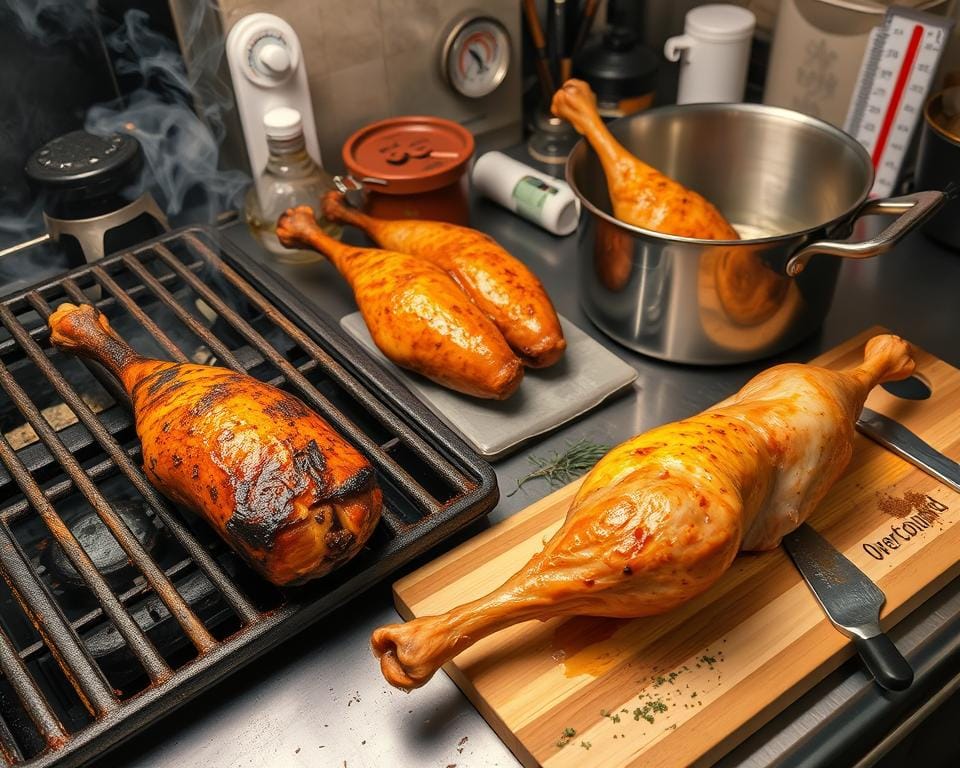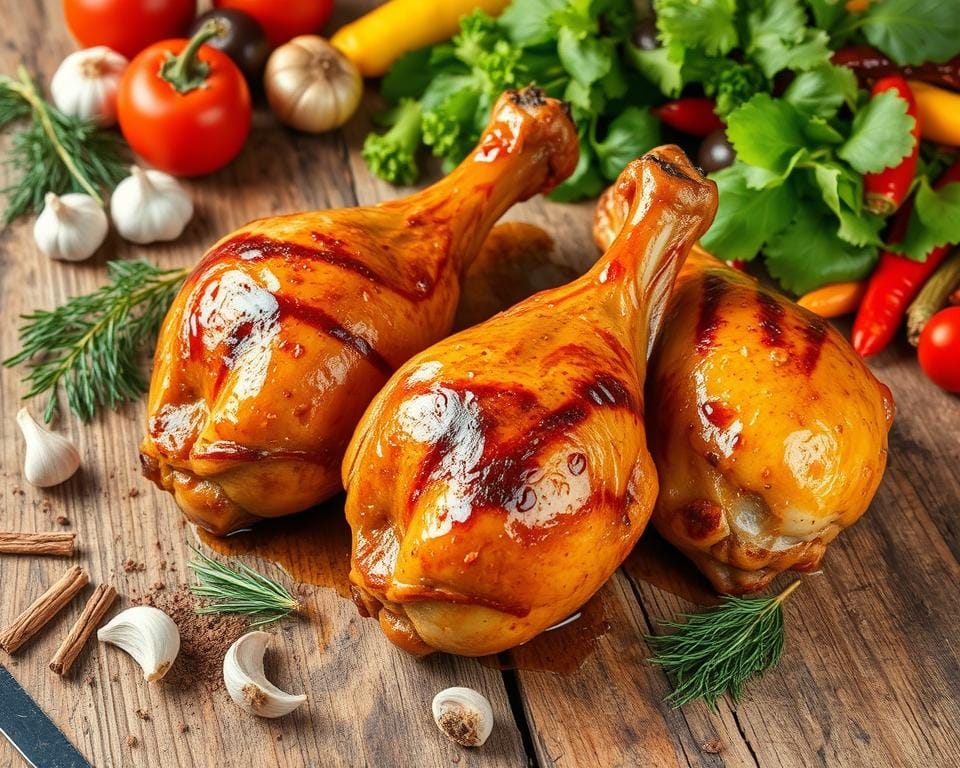Turkey Leg Recipe: Mouthwatering, Juicy, and Flavorful Ideas
As autumn arrives, the smell of roasted turkey legs fills the kitchen. It invites you to enjoy a cozy and tasty meal. Turkey legs are often ignored for the whole turkey. But they offer a special dining experience all year, not just holidays.
In this guide, we’ll show you how to cook turkey legs perfectly. We’ll cover choosing the right size and the best cooking method. These recipes are perfect for any meal, big or small, making your dinners delicious and satisfying.
Table of Contents
Understanding Turkey Leg Selection and Preparation
Choosing the right turkey leg is key for a juicy and flavorful dish. Turkey legs usually weigh 10-12 ounces each. This size is perfect for a hearty meal. For bigger legs, about 1 pound, you’ll need to adjust cooking time and temperature.
Choosing the Right Size Turkey Legs
Go for bone-in, skin-on turkey legs for the best taste and texture. Legs that weigh 10-12 ounces each are ideal. This size ensures even cooking and a crispy skin with tender meat.
Preparing Turkey Legs for Cooking
Before seasoning, pat the turkey legs dry with paper towels. This step removes excess moisture. It helps create a crispy, golden-brown skin when cooked.
Essential Kitchen Tools Needed
- Rimmed baking sheet
- Oven-safe rack
- Meat thermometer
- Aluminum foil (for easy cleanup)
With the right turkey leg size and preparation, you’re set for juicy, flavorful results. Paying attention to detail is crucial. It ensures even cooking and a crispy skin that will impress your taste buds.
Essential Ingredients for Perfect Turkey Legs
To make juicy and flavorful turkey legs, start with the right ingredients. You need the turkey legs, along with seasonings and oils to boost the taste.
The turkey leg ingredients are crucial. Choose large, meaty legs without blemishes. You’ll need about 2 pounds (1 kilogram) for a great meal.
The seasoning blend makes the turkey legs stand out. Mix salt, black pepper, garlic powder, paprika, thyme, rosemary, and chili flakes. Adjust the seasonings to your liking.
For the turkey leg marinade or glaze, use olive or avocado oil and melted butter. These fats help the seasonings stick and add flavor and texture.
| Ingredient | Quantity |
|---|---|
| Turkey Legs | 2 pounds (1 kg) |
| Olive Oil or Avocado Oil | 2 tablespoons |
| Melted Butter | 2 tablespoons |
| Salt | 2 tablespoons |
| Black Pepper | 2 tablespoons |
| Garlic Powder | 2 tablespoons |
| Paprika | 1/4 cup |
| Dried Thyme | 1 tablespoon |
| Dried Rosemary | 1 tablespoon |
| Chili Flakes (optional) | 1 teaspoon |
With these turkey leg ingredients and seasonings, you’re ready to make a delicious turkey leg dish. It’s sure to impress your family and guests.
Simple Turkey Leg Recipe for Beginners
Cooking turkey legs can be easy and fun. This simple recipe is great for beginners. It’s perfect for family gatherings or a satisfying meal at home. Follow this guide for delicious turkey legs every time.
Basic Seasoning Blend
To make the perfect seasoning blend, mix these ingredients:
- 1 teaspoon kosher salt
- 1 teaspoon paprika
- 1/2 teaspoon garlic powder
- 1/2 teaspoon onion powder
- 1/4 teaspoon black pepper
- 1/2 teaspoon dried thyme
- 1/2 teaspoon dried sage
Step-by-Step Cooking Process
Here’s how to cook your turkey legs:
- Preheat your oven to 374°F (190°C).
- Pat the turkey legs dry and place them in a baking dish.
- Rub the seasoning blend all over the turkey legs.
- Melt 3 tablespoons of butter and brush it on the turkey legs.
- Cover the dish with foil and roast for 40 minutes.
- Take off the foil and roast for another 40 minutes. The turkey should be 175-180°F (79-82°C) inside.
- Let the turkey legs rest for 30 minutes before serving.
Temperature and Timing Guidelines
Follow these guidelines for perfect turkey legs:
| Turkey Leg Weight | Total Cooking Time | Internal Temperature |
|---|---|---|
| 2 turkey legs (1400g total) | 1 hour 20 minutes | 175-180°F (79-82°C) |
The cooking time can change based on the turkey legs’ size and weight. Always check with a meat thermometer to make sure they’re cooked right.
Achieving Crispy Skin While Maintaining Juiciness
Getting the perfect crispy turkey leg skin and juicy meat is a challenge. But, with some key techniques, you can do it. You’ll get a turkey leg that’s crunchy on the outside and juicy inside.
First, dry your turkey legs well before seasoning. This step removes excess moisture. Then, cook them at 450°F (232°C) to start crisping the skin.
When the skin turns golden, lower the oven to 350°F (175°C). This helps the meat cook without burning the skin. Don’t open the oven door too often to keep the heat even.
While cooking, baste the turkey legs with pan juices or oil. This helps with even browning. For extra crispiness, broil them for 2-3 minutes, but watch them to avoid burning.
“The secret to perfectly crispy turkey leg skin is all about managing the temperature and moisture levels during the cooking process,” shares the expert chefs at Mahogany Smoked Meats, who have been smoking meats for over a century. “It’s a delicate balance, but with a little practice, you’ll be creating juicy, crispy-skinned turkey legs that are sure to impress.”
By using these tips, you’ll get the best crispy turkey leg skin and juicy turkey legs. Your guests will love them. Serve them with your favorite sides for a memorable meal.
| Technique | Temperature | Time | Result |
|---|---|---|---|
| Cook in air fryer | 375°F (190°C) | 25-30 minutes | Crispy skin, juicy meat |
| Dry brine | N/A | 24-48 hours | Seasoned, crispy skin |
| Smoke turkey legs | 225°F to 400°F | 30-40 minutes per pound | Smoky, crispy skin |
Flavor-Enhancing Marinades and Brines
Discover the secret to making your turkey legs taste amazing. Try using marinades and brines. These methods make your turkey legs juicy and tender.
Wet Brine Solutions
Wet brining is a great way to add flavor to your turkey legs. You soak them in a mix of salt, sugar, and water. Add herbs and spices for extra taste.
Let the legs soak for 4-8 hours. This lets the brine soak into the meat. Your turkey will be moist and full of flavor.
Dry Brine Techniques
Dry brining is a hands-on option. Rub salt and seasonings on the turkey legs. Let them rest for 8-24 hours.
This method tenderizes the meat and keeps it juicy. It’s a simple way to enhance your turkey’s flavor.
Marinade Variations
Marinades offer endless flavor options. They’re made with oil, acid, and herbs. You can choose from many flavors like herbs, citrus, or spicy.
Whether you choose wet brining, dry brining, or a marinade, your turkey will be amazing. Try different flavors to find your favorite.
| Brine Technique | Advantages | Disadvantages |
|---|---|---|
| Wet Brine |
|
|
| Dry Brine |
|
|
| Marinade |
|
|
Using turkey leg brine, turkey leg marinade, or brining turkey legs will make your dishes better. Your turkey will be juicy and full of flavor.
Advanced Cooking Methods for Turkey Legs
Looking to take your turkey leg game up a notch? Several advanced cooking methods can help you achieve amazing results. Try smoked turkey legs for a smoky flavor or air-fried turkey legs for crispy perfection. These techniques will elevate your dish to new heights.
Smoked Turkey Legs
Smoking your turkey legs adds a deep, smoky flavor. Use wood chips like hickory or apple. Smoke the legs at 225-250°F (107-121°C) for 2-3 hours. This slow process infuses the meat with a rich, irresistible smoke aroma.
Grilled Turkey Legs
Grilling turkey legs gives you a crispy, charred exterior and juicy interior. Grill them at indirect heat for 1-1.5 hours, turning them occasionally. This way, they’ll reach the perfect doneness.
Air Fryer Turkey Legs
Cooking turkey legs in an air fryer is quick and easy. Set the temperature to 380°F (193°C) and cook for 20-25 minutes. Flip them halfway through until the skin is crispy and the meat is cooked through.
Sous Vide Turkey Legs
The sous vide method produces incredibly tender and juicy turkey legs. Cook them in a water bath at 165°F (74°C) for 4-6 hours. Then, finish them in a hot skillet or under the broiler for crispy skin.
| Cooking Method | Temperature | Time |
|---|---|---|
| Smoked Turkey Legs | 225-250°F (107-121°C) | 2-3 hours |
| Grilled Turkey Legs | Indirect Heat | 1-1.5 hours |
| Air Fryer Turkey Legs | 380°F (193°C) | 20-25 minutes |
| Sous Vide Turkey Legs | 165°F (74°C) | 4-6 hours |
Try these advanced cooking methods to find your perfect turkey leg recipe. Whether you like the smoky flavor of smoked turkey legs, the crispy exterior of grilled or air-fried legs, or the tenderness of sous vide, these techniques will take your dish to new levels.

Perfect Side Dishes to Complement Your Turkey Legs
Choosing the right side dishes can elevate your turkey leg feast. There are many options, from classic Thanksgiving dishes to modern twists. Each one can enhance the flavors of your juicy turkey legs.
Traditional Pairings
Classic side dishes like mashed potatoes, cranberry sauce, green bean casserole, and stuffing are timeless. They bring out the turkey’s flavors and bring back cozy Thanksgiving memories.
Modern Side Dish Options
For a modern twist, try roasted Brussels sprouts, cauliflower mash, quinoa salad, or roasted root vegetables. These sides offer a refreshing contrast to the turkey’s richness.
For a healthier option, consider sautéed green beans, roasted sweet potatoes, or a kale salad. They’re nutritious and complement the turkey well.
Remember to serve your sides with a flavorful gravy made from turkey drippings. This adds an extra layer of taste. Choose sides that can cook at the same temperature as your turkey legs for convenience.
| Traditional Sides | Modern Sides | Healthy Sides |
|---|---|---|
| Mashed Potatoes | Roasted Brussels Sprouts | Sautéed Green Beans |
| Cranberry Sauce | Cauliflower Mash | Roasted Sweet Potatoes |
| Green Bean Casserole | Quinoa Salad | Kale Salad |
| Stuffing | Roasted Root Vegetables |
Troubleshooting Common Turkey Leg Cooking Issues
Cooking turkey legs can be tricky, but with the right techniques, you can avoid common problems and enjoy juicy, flavorful results. Whether you’re dealing with dry, overcooked meat or undercooked and rubbery legs, these tips will help you troubleshoot and fix the issue.
Preventing Dryness
One of the most common problems with turkey legs is dryness. To prevent this, be careful not to overcook the meat. Use a meat thermometer to ensure the internal temperature reaches 165°F (74°C), and avoid leaving the legs in the oven for too long. If the meat is already dry, try shredding or pulling it off the bone to manage the toughness.
Addressing Undercooked Legs
If your turkey legs are still pink and undercooked, return them to the oven and check every 5-10 minutes until the internal temperature reaches the recommended 165°F (74°C). If the skin is browning too quickly, loosely tent the legs with foil to prevent the exterior from overcooking while the interior finishes.
Fixing Rubbery Skin
Crispy skin is a hallmark of perfectly cooked turkey legs, but sometimes, it can turn out rubbery. To fix this, try briefly broiling the legs for a minute or two, or increase the oven temperature for the last few minutes of cooking to help the skin crisp up.
Balancing Saltiness
If your turkey legs are too salty, you can balance the flavor by serving them with a creamy sauce or a squeeze of fresh lemon juice. This can help offset the saltiness and make the overall dish more palatable.
Ensuring Even Cooking
Uneven cooking is another common issue with turkey legs. To avoid this, try to select legs that are similar in size, and adjust the cooking times accordingly. If the legs vary greatly in size, consider separating them and cooking the smaller pieces for less time.
By addressing these common turkey leg cooking problems, you can enjoy tender, juicy, and flavorful results every time. With a little troubleshooting and the right techniques, you’ll be serving up delicious turkey legs that will impress your guests.

Storage and Reheating Guidelines
Keeping your cooked turkey legs juicy and tasty is key. Whether you have leftovers from a holiday or made them ahead, these tips will help. You’ll enjoy every bite.
Storing Cooked Turkey Legs
Put cooked turkey legs in an airtight container and chill for 3-4 days. Freeze them for up to 6 months for longer storage. Wrap them in plastic or foil before freezing to avoid freezer burn.
Reheating Cooked Turkey Legs
Ready to eat your turkey legs? Here are a few ways to reheat them:
- Oven: Heat your oven to 350°F (175°C). Place turkey legs in a dish, cover with foil, and warm for 20-30 minutes. Check the temperature reaches 165°F (74°C).
- Air Fryer: Reheat at 350°F (175°C) for 10-15 minutes, flipping halfway. This makes them crispy and hot.
- Microwave: Thaw first, then heat on 50% power for 2-3 minutes per leg. This method is quick and easy.
Don’t overheat the turkey to keep it moist. Always check the temperature with a meat thermometer. It should be 165°F (74°C) before serving.
By following these easy steps, your leftover turkey legs will taste just as good as the first day. Enjoy!
Creative Leftover Turkey Leg Recipes
Don’t let those flavorful turkey legs go to waste after your Thanksgiving feast! Turn them into delicious dishes that will excite your taste buds. From hearty soups to refreshing salads, the possibilities are endless.
Start by shredding the meat from the turkey legs. This versatile ingredient can be the foundation for a comforting turkey leg soup or a zesty turkey salad packed with crunchy veggies and herbs. For a twist on classic Thanksgiving flavors, use the shredded turkey in savory turkey pot pie or spice things up with turkey tacos or turkey quesadillas.
- Turkey Noodle Soup: Simmer shredded turkey legs with carrots, celery, onions, and egg noodles for a soul-warming winter meal.
- Turkey Salad: Mix shredded turkey with mayonnaise, diced celery, red onion, and fresh parsley for a delightful sandwich or salad topping.
- Turkey Pot Pie: Layer shredded turkey, vegetables, and a homemade gravy in a pie crust for a comforting and satisfying dish.
- Turkey Tacos or Quesadillas: Combine shredded turkey with taco seasoning, cheese, salsa, and your favorite taco toppings.
For a healthier option, add the leftover turkey to a nourishing grain bowl with roasted vegetables and a light dressing. The possibilities are endless when it comes to transforming your Thanksgiving turkey legs into creative and delicious meals.
Remember, the key to repurposing your turkey leg leftovers is to get creative and have fun in the kitchen. Experiment with different flavors, cooking methods, and ingredient combinations to find your new favorite way to enjoy this versatile protein.
Conclusion
Turkey legs are a tasty choice for smaller meals or gatherings. They are easy to cook and offer a delicious alternative to a full turkey. The secret to great turkey legs is in the seasoning, cooking temperature, and letting the meat rest before serving.
Try different cooking methods and marinades to find your favorite recipe. A meat thermometer is key to ensuring your turkey legs are safe and cooked just right. This way, you can enjoy tender, flavorful turkey legs any time.
Whether you’re new to cooking or have years of experience, this guide has everything you need. It will help you make the best turkey leg recipe summary, learn the best turkey leg cooking methods, and use turkey leg cooking tips to improve your cooking.

